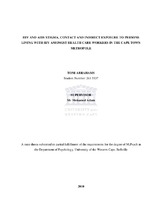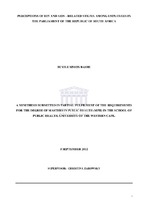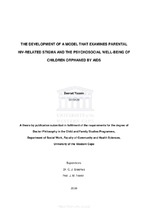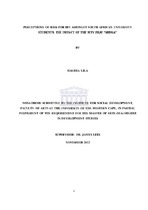| dc.contributor.advisor | Adam, Mohamed E. | |
| dc.contributor.author | Abrahams, Toni | |
| dc.contributor.other | Dept. of Psychology | |
| dc.contributor.other | Faculty of Arts | |
| dc.date.accessioned | 2013-10-25T12:59:01Z | |
| dc.date.available | 2011/02/24 08:42 | |
| dc.date.available | 2011/02/24 | |
| dc.date.available | 2013-10-25T12:59:01Z | |
| dc.date.issued | 2010 | |
| dc.identifier.uri | http://hdl.handle.net/11394/2375 | |
| dc.description | Magister Psychologiae - MPsych | en_US |
| dc.description.abstract | The appeal of Allport's Contact Hypothesis lies in the simplicity of its core principle, which holds that contact between different groups may serve to reduce prejudices. Contact needs to meet key conditions, i.e. equal power, cooperation towards a common goal and institutional support. Support has been found for the Contact Hypothesis in its original form and for those contacts which fail to meet the specified conditions. This study sought to explore whether contact, in forms different to those traditionally defined by the Contact Hypothesis, i.e. exposure, had any bearing on group prejudice. The prejudice and its underlying negative attitudes of interest, were those informed by HIV and AIDS stigma. HIV and AIDS stigma, defined as a discrediting quality and informed by social processes, is of particular concern as it impedes prevention, treatment and care efforts in South Africa's response to the HIV and AIDS epidemic. The health care context is often an area where Persons Living with HIV (PLHIV) are confronted with HIV and AIDS stigma. The research aims were thus to explore the extent of HIV and AIDS stigma amongst health care workers, the forms of exposure to PLHIV and the relationship between exposure and HIV and AIDS stigma. A quantitative, survey design was employed to accomplish these aims and to test formulated hypotheses, which were based on current literature and the core principle of the Contact Hypothesis. The sample consisted of 202 health care workers in the Cape Town metropole. Data analyses revealed the existence of low to moderate levels of HIV and AIDS stigma and also found that most of the sample had exposure to PLHIV in either its individual forms or overall form. Bivariate correlations revealed negative relationships between forms of exposure, overall exposure and stigma. | en_US |
| dc.language.iso | en | en_US |
| dc.publisher | University of the Western Cape | en_US |
| dc.subject | HIV and AIDS | en_US |
| dc.subject | Stigma | en_US |
| dc.subject | Disease stigma | en_US |
| dc.subject | HIV and AIDS-related stigma in South Africa | en_US |
| dc.subject | Indicators of HIV and AIDS-related stigma | en_US |
| dc.subject | Health care worker attitudes | en_US |
| dc.subject | Stigma reduction | en_US |
| dc.subject | Contact Hypothesis | en_US |
| dc.subject | Quantitative study | en_US |
| dc.subject | Survey | en_US |
| dc.title | Hiv and Aids stigma, contact and indirect exposure to persons living with HIV amongst health care workers in Cape Town Metropole | en_US |
| dc.type | Thesis | en_US |
| dc.rights.holder | University of the Western Cape | en_US |
| dc.description.country | South Africa | |




